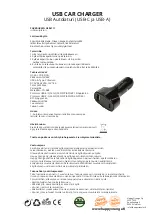
steering, acceleration or braking which
could result in an increased risk of loss of
vehicle control, vehicle rollover and/or
personal injury. Use all available road
surface to return the vehicle to a safe
direction of travel.
•
In the event of an emergency stop, avoid
skidding the tires and do not attempt any
sharp steering wheel movements.
•
If the vehicle goes from one type of
surface to another (i.e., from concrete to
gravel) the way the vehicle responds to
a maneuver changes (steering,
acceleration or braking). Again, avoid
these abrupt inputs.
Sand
When driving over sand, try to keep all four
wheels on the most solid area of the trail.
Avoid reducing the tire pressures but shift to
a lower gear and drive steadily through the
terrain. Apply the accelerator slowly and
avoid excessive wheel slip.
Do not drive your vehicle in deep sand for an
extended period of time. This could cause
the AWD system to overheat and default to
front-wheel drive. If this occurs AWD Off
displays in the Information Display. To
resume normal AWD function as soon as
possible, stop the vehicle in a safe location
and stop the engine for at least 10 minutes.
After the engine restarts and the AWD
system has adequately cooled, the AWD Off
message turns off and normal AWD function
returns. In the event you do not stop the
engine, the AWD Off message turns off when
the system cools and normal AWD function
returns.
When driving at slow speeds in deep sand
under high outside temperatures, use a low
gear when possible. Low gear operation
maximizes the engine and transmission
cooling capability. Under severe operating
conditions, the A/C may cycle on and off to
protect overheating of the engine.
Avoid excessive speed because vehicle
momentum can work against you and cause
the vehicle to become stuck to the point that
assistance may be required from another
vehicle. Remember, you may be able to back
out the way you came if you proceed with
caution.
Mud and Water
If you must drive through high water, drive
slowly. Traction or brake capability may be
limited.
When driving through water, determine the
depth; avoid water higher than the bottom
of the wheel rims (for cars) or the bottom of
the hubs (for trucks) (if possible) and
proceed slowly. If the ignition system gets
wet, the vehicle may stall.
E142667
Once through water, always try the brakes.
Wet brakes do not stop the vehicle as
effectively as dry brakes. Drying improves
when you move your vehicle slowly while
applying light pressure on the brake pedal.
144
MKS (), enUSA
All-Wheel Drive
(If Equipped)
Содержание 2015 MKS
Страница 3: ...I n f o r ma t i o nP r o v i d e db y ...
Страница 9: ...6 MKS enUSA I n f o r ma t i o nP r o v i d e db y ...
Страница 115: ...E138647 112 MKS enUSA Seats I n f o r ma t i o nP r o v i d e db y ...
Страница 192: ...Example only E142516 E142517 189 MKS enUSA Load Carrying I n f o r ma t i o nP r o v i d e db y ...
Страница 195: ...Example only E142523 192 MKS enUSA Load Carrying I n f o r ma t i o nP r o v i d e db y ...
Страница 301: ...E142732 298 MKS enUSA Capacities and Specifications I n f o r ma t i o nP r o v i d e db y ...
















































